12.4 Advanced Antenna Technologies in WiMAX
12.4 Advanced Antenna Technologies in WiMAX
To improve radio performance, antenna technologies are very often used in cellular systems. A very popular solution in a wireless transmission system is to use receiver diversity at the BS side. The signals transmitted by the terminal are received at the BS by multiple antennas (usually two or four) and the signals from the different received paths are combined. A very popular technique for combining these different signals is the Maximum Ratio Combining (MRC) technique, which combines (or weights) the same symbol received from each branch according to their reception quality. The outcome is an increase in the receiver sensibility at the BS and consequently a range extension and/or the possibility to use a less robust radio transmission mode for a higher transmission rate. The order of magnitude of the improvement is of the order of the diversity order, e.g. for a system with two receiver antennas, the gain is typically about 3 dB.
The received diversity scheme is very efficient if the signals coming from the different antennas are uncorrelated. The correlation of the antenna mainly depends on the distance between the antennas (usually, a separation of 10 to 20 λ is required in a macrocellular environment): this is called spatial diversity. An operational alternative to such antenna configurations is to use cross-polarised antennas; this limits the visual impact on the environment.
The implementation and support of simple receive diversity in a BS is vendor-specific and does not require any standard mechanisms. Presently, more advanced antenna techniques also exist: smart antenna technology with beamforming and MIMO antennas. Each technology has its own advantages and system deployment constraints are developed further in the next subsections.
Also, both technologies require the support of the standard in order to get the full benefits of their operation. The IEEE 802.16 standards, especially the IEEE 802.16e amendment, provide all the hooks for the support of both antenna technologies.
12.4.1 Beamforming or AAS Technogies
Beamforming technologies may be encountered behind several wordings: smart antenna, beamforming and Adaptive Antenna System (AAS). In the following beamforming will be used.
12.4.1.1 Beamforming Basics
The main objective of beamforming technology is to take benefit from the space/time nature of the propagation channel. Indeed, due to multiple reflections, diffraction and scattering on the transmitter to receiver path in a cellular environment, the energy reaching the BS comes from multiple directions, each direction being affected by a different attenuation and phase.
In a macrocellular environment (i.e. the antenna of the BS is above the rooftop) the signals reaching the BS are inside a cone. The angular spread of the signal depends on the environment. In a urban environment, the angular spread is of the order of 20 degrees. In a more open environment, like in a rural environment, the angular spread is a few degrees.
In the uplink, the beamforming technology principle is to coherently combine the signals received for N antenna elements of an antenna array. A generic beamforming diagram is shown in Figure 12.2. A block diagram of a beamforming receiver (respectively transmitter) with an N-element antenna array is shown in figure 12.2 (respectively figure 12.3). In the case of a block diagram of a beamforming receiver with an N-element antenna array, a signal processing unit analyses the same signal received from the N antenna elements and computes weights (wi) that are applied on each path for combining.
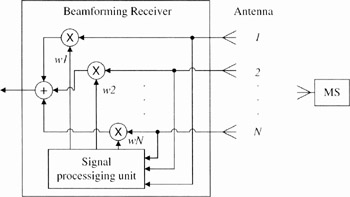
Figure 12.2: Example of a block diagram of a beamforming receiver with an N-element antenna array
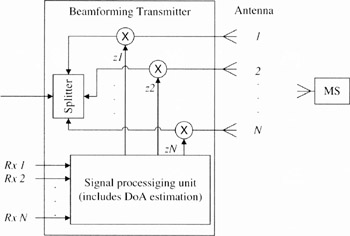
Figure 12.3: Example of a block diagram of a beamforming transmitter with an N-element antenna array
On the downlink, the processing is very similar to the uplink. Based on the information measured on the signal received in the uplink, it is possible to estimate the Direction of Arrival (DoA) from the uplink signal and to apply different weights, zi (amplitude and phase), to the different transmit paths of the same signal, so that the resulting antenna pattern focuses towards the direction of the user.
Since the weights in the downlink depend on the uplink signals, this assumes certain channel reciprocity between the uplink and downlink signals since the BS do not know the downlink spatial channel response. Actually, the reciprocity can more realistically be assumed in the case of the TDD system since the uplink and downlink signals use the same frequency at different time intervals. On the FDD system, the reciprocity is more difficult to assess.
In fact, beamforming technology encompasses several techniques. First implementations of beamforming were based on simple antenna switching mechanisms: in that approach, the elements of the antenna array where simply switched on or off according to the received signals. This has the advantage of simplicity but the possibility for beamforming is limited. Today, beamforming uses an adaptive array: the amplitude and phase of each antenna element can be set independently. This has the advantage of having the possibility to achieve infinity of beams.
With adaptive beamforming, several optimising strategies may be used. The signal processing unit must maximise the received CINR. This can be achieved by having a resulting antenna pattern such that the antenna array creates a null in the direction of arrival of a strong interferer. However, the number of interferers that can be cancelled are limited by the number of elements constituting the array: with N antenna elements, it possible to have at most null N−1 interferers. In addition, this technique requires a good knowledge of the radio environment (which may imply additional overheads). This explains why in many implemented systems this method is mainly used in the uplink, where the BS can have maximum knowledge of the radio environment.
Finally, an advanced implementation of beamforming can enable SDMA (Spatial Division Multiple Access). Provided that two or more users are sufficiently separated in space, it is possible to send them at the same time, on the same physical resources, different information on different beams. Nevertheless, the use of SDMA is quite difficult in a mobile environment where MSs that may be well separated at a given moment may be in the same direction at the next moment. More details on smart antennas can be found in [27] and [28].
12.4.1.2 System Design Aspects on BS and MS
All the complexity and intelligence of a beamforming system is inside the base station. In addition to the spatial signal processing unit, the BS includes as many transceivers as the number of antenna elements. Usually, wireless systems implementing beamforming are operating between two to eight antenna elements and transceivers.
On the MS side, the impact for the support of beamforming is minor. Basically, beamforming can be applied to any MS. However, in order to provide better performance, the standards (and in particular IEEE 802.16e) define additional messages/procedures between the BS and the MS. Nevertheless, there is no hardware impact on the terminal side; only some additional software is needed for an optimised beamforming operation.
The beamforming algorithms aim to combine coherently the signal transmitted/received from different antenna elements. In order to achieve this correlation, the antenna elements need to be closely separated. For an optimum performance of beamforming, a spacing of half the wavelength λ is preferred. Consequently, assuming a four-element antenna array at 2.5 GHz would result in an antenna of about 22 to 25 cm width. The array itself is thus of a relatively small size, which is very beneficial for visual impacts on the environment.
Besides, in order to maintain the signal coherence, mechanisms for calibrating the different transmit/receive paths are required, the algorithm for doing this being vendor-specific.
12.4.1.3 Benefits of Beamforming
The benefits of beamforming are manyfold: range increase and power saving at the MS side, interference mitigation and capacity increase.
First, beamforming improves the link budget for the data transmission for both the downlink and the uplink. Indeed, by concentrating the energy in one direction, the resulting antenna gain in one direction is significantly increased (see Figure 12.4). This additional gain is beneficial for improving the coverage of the BS (less sites needed for a deployment) and/or for reducing the power needed by the MS to transmit signals (power saving).

Figure 12.4: Range extension with beamforming
Theoretical gains, compared with a conventional antenna, for an N-element antenna arrays are of 10×log(N) for the uplink and 20×log(N) for the downlink. For example, with a four-element antenna arrays the gains are respectively of 6 dB (12 dB) for the uplink (respectively the downlink). The gain in the downlink is higher since, on top of the beamforming gain, the power from each transmitter coherently increases. The value of those gains has been validated in many experiments on the field and proves to be in line with the theory [29]. Additional gains are measured in the uplink due to the additional spatial diversity gain.
Second, because the energy is focused in the direction of the user, there is a general interference reduction in a cellular system employing beamforming. Indeed, when beamforming is deployed on the BS of a given geographical area, the beams are oriented as a function of the repartition of the users served in a cell; at one moment, on a given radio resource, a single user is served. As a consequence, the interference created by the communication of this user is only in a restricted angle compared to sectorised antenna deployment (see Figure 12.5).
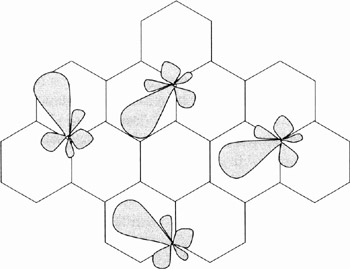
Figure 12.5: Interference reduction with beamforming
The angle spread of the main lobe is approximately the total angle of the sector divided by the number of antenna elements N. For example, with a four-element antenna array and a 90° antenna, the resulting main lobe width (at −3 dB) is around 220°. Therefore, since the users are randomly spread, the beam directions change according to the user locations, which create additional interference diversity gain. The interference reduction is further improved with the use of explicit interference cancellation algorithms.
Two direct consequences of the interference reduction are: a better signal quality and availability across the cell area and a better capacity in the cell for systems using link adaptation. Indeed, since the CINR values are better, the possibility of using a better modulation and coding scheme is higher.
12.4.1.4 Support of Beamforming in the IEEE 801.16 Standards
Beamforming is defined in IEEE 802.16-2004 and in 802.16e. This feature is not in the set of the fixed WiMAX profiles. For the mobile WiMAX profiles, this feature is mandatory to be supported by the MS and optional for the BS. For the mobile WiMAX, several mechanisms that enhance the performance and operation of beamforming are provisioned.
In the downlink, in order to be able to beamform several users at the same and on different subchannels, a zone is dedicated (indicated in the DL-MAP). This region, labelled (2) in Figure 12.6, contains permutations with dedicated pilot channels. This means that an MS receiving a burst in this region only takes as valid pilots the pilots associated with the subchannel it has been allocated.
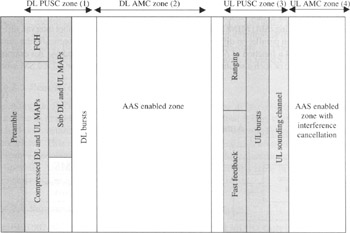
Figure 12.6: Example of a frame with regions supporting AAS operation
In the uplink, as mentioned previously, the beamforming mechanisms can be applied on any MS. However, to improve the performance and to help the BS in detecting/measuring the interference experienced by the users it wants to serve, a specific signalling zone may be allocated: the uplink sounding zone (indicated by UIUC=13). Actually, the BS may ask some MS to transmit a signal in this zone so that the BS can evaluate the interference on some subcarriers for those MSs.
Finally, in order to limit the signalling overhead, the WiMAX solution employing beamforming may use the compressed maps and submaps to transmit the common signalling messages (DL-MAP/UL-MAP). Indeed, this permits different modulation, coding and repetition schemes to be applied to several zones in the DL-MAP/UL-MAP message. This solution can also be employed in the case of MIMO or the support of the HARQ.
12.4.2 MIMO (Multiple-Input Multiple-Output) Solution
12.4.2.1 MIMO Basics
MIMO systems use multiple input and multiple output antennas operating on a single channel (frequency). At the transmitter side, the signal is space–time encoded and transmitted from NT antennas. At the receiving side, the signals are received from NR antennas (see Figure 12.7). The space–time decoder combines the signal received by the NR antennas and transmitted from the NT antennas after having estimated the channel matrix (NT×NR).

Figure 12.7: Generic MIMO block diagram for the downlink
The objective of the MIMO solution is to exploit the space and time diversity of the channels on the different radio paths between each combination of transmit/receive antennas to improve the reception sensitivity and/or to improve the channel capacity. There are several families of MIMO solutions. The two extreme ones are the spatial diversity MIMO schemes and the spatial multiplexing MIMO schemes.
Spatial diversity MIMO refers to solutions where the same information is transmitted (after space–time coding) in space and time. The theoretical diversity gain of such a solution is a function of the product of the transmit/receive antennas and is equal to NT×NR. For instance, a MIMO system implementing four antennas at the BS side and two antennas at the MS side has a diversity gain of 9 dB. An example of such a scheme is the Alamouti space–time code (STC) [30]. The space–time code of this 2×1 solution is given by the following matrix:
![]()
In matrix A, S1 and S2 are the symbols to be transmitted over the air. At symbol k, symbol S1 is transmitted from antenna 1 and S2 is transmitted from antenna 2. At symbol k + 1, symbol −S2* is transmitted from antenna 1 and symbol S1* is transmitted from antenna 2 Si* is the complex conjugate of symbol Si).
Spatial Multiplexing (SM) MIMO refers to solutions where, during a symbol interval, different information is sent in parallel on different antennas. With this scheme, theoretically the capacity increases linearly as a function of N, N being the minimum between NT and NR. An example of the space–time code of such a solution is given by the following formula for a 2 × 2 SM scheme:

With the SM code, the capacity of the channel and the burst transmitted rate are increased. However, this only happens under very good CINR conditions and a highly uncorrelated channel.
In addition, several MIMO schemes exist that are a mix between SM and spatial diversity schemes. The diversity order and capacity increase depends on the space–time code and number of antennas.
More recently, MIMO schemes using pre-coding have been defined. In these cases, the space–time code depends on a feedback from the receiver on the channel states. Indeed, this solution requires a closed-loop operation and additional signalling between the receiver and the transmitter.
Finally, MIMO can also be generated from signals transmitted from different BSs (virtual MIMO). This requires time synchronisation of the BS but also a synchronisation of the scheduler of the BS involved in the transmission. More details on the MIMO scheme can be found in Reference [31] or [32].
12.4.2.2 System Design Aspects of BS and MS
As indicated in Figure 12.7, MIMO operation has a significant impact on the design of the BS and the MS. Indeed, in addition to the MIMO codes, the algorithms for encoding and decoding MIMO signals, there is the requirement to implement several transmitter and several receivers both at the BS and MS sides. This may be critical for the MS side. Indeed, implementing several receiver chains implies several antennas on a small device and additional hardware and processing power. Moreover, several transmitters at the MS side also mean significant additional power consumption. Efficient implementation of MIMO at the MS side has then some technological challenges to be solved.
The preferred antenna configuration for MIMO is when the multiple antennas are perfectly uncorrelated. In that case, the performances of MIMO are optimal. Good correlation is obtained if at the BS side the antennas are separated by 10 to 20 λ and at the MS side by at least λ. The latter requirement makes solutions with more than two antennas at the MS impractical.
In some cases, the additional effort needed for the space–time decoder is significant. This also imposes some limits on the number of transmit antennas at the BS side.
12.4.2.3 Benefits of MIMO
Depending on the scheme, the benefits of MIMO can be to improve the receiver sensitivity and/or to multiply the capacity and the peak rates. However, as stated previously, to get the best performance from MIMO, the different receive/transmit channels should be highly uncorrelated. This is achieved in the environment with very high scattering and signals coming from a very large angular spread (e.g. in a microcellular environment).
Especially, the SM schemes are very sensitive to correlation since in the case of a correlated channel, the SM scheme creates additional interference.
12.4.2.4 Support of MIMO in the IEEE 801.16 Standards
The IEEE 802.16-2004 standard provides a few supports for MIMO. Only the Alamouti scheme as defined by Equation (12.6) is defined and is not mandatory in the profile for fixed/nomadic WiMAX systems. On the contrary, IEEE 802.16e provides extensive support for MIMO.
Out of the schemes defined in the standard, the WiMAX Forum has selected two MIMO schemes for the downlink with two antennas at the BS side and two antennas at the MS side. The schemes are those defined in equations (12.6) and (12.7). Downlink MIMO support in IEEE 802.16e is shown in figure 12.8. In the downlink, the mobile WiMAX solution can either benefit from the additional diversity gain or doubled capacity and peak rate.
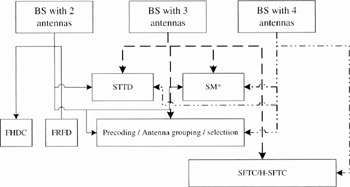
Figure 12.8: Downlink MIMO support in IEEE 802.16e (based on Reference [2]). STTD=Space Time Transmit Diversity, SM=Spatial Multiplexing (*SM mode requires at least two antennas at the MS side), FHDC = Frequency Hopped Diversity Coding, FRFD = Full Rate Full Diversity. SFTC = Space Frequency Time Code and H-SFTC = Hybrid SFTC
In the uplink, among all the options included in the standard (see Figure 12.9), only one scheme has been selected for mobile WiMAX: collaborative SM. With collaborative SM, two MSs, equipped with a single transmitter, send different data information at the same time on the same channels. In such a mode, the users can be discriminated with the help of pilot symbols, which use different tones for each user (each MS transmits half of the total available pilots).

Figure 12.9: Uplink MIMO support in IEEE 802.16e-2005. (Based on Reference [2].)
In the uplink, MIMO can improve the capacity of the mobile WiMAX system by providing sufficient signal quality. Of course, since the use of SM is sensitive to the radio condition, a MIMO solution may include the solution to switch to the best MIMO mode depending on the signal quality.
Indeed, MIMO operation implies that the signals transmitted over the air have a specific format. In order to mix users operating with MIMO with other users in one frame, MIMO zones are defined (indicated in the DL-MAP message). For instance, Figure 12.10 is an example of a frame mixing MIMO and non-MIMO zones. In this figure, zone (1) includes the common signalling channels and some downlink bursts (using a PUSC permutation). Zone (2) is the MIMO zone for the downlink. Zone (3) is the zone in the uplink for users who cannot use collaborative MIMO (e.g. because their estimated signal-to-interference level is too weak). Zone (3) also includes common uplink signalling messages for ranging, fast feedback, etc. Finally, zone (4) is the uplink MIMO zone.
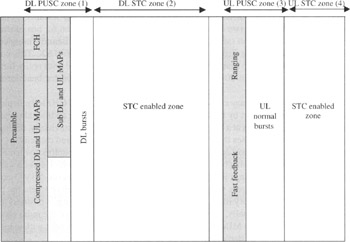
Figure 12.10: Example of a frame with regions supporting the MIMO operation
12.4.3 About the Implementation of Advanced Antenna Technologies
As discussed in previous sections, beamforming and MIMO are key solutions to provide spectral efficiency for a mobile WiMAX system, making it superior to the spectral efficiency of other existing cellular systems. Also, both MIMO and AAS technologies (in particular in the light of the choices made by the WiMAX Forum) have different and complementary benefits.
Beamforming (or AAS), since it provides link budget gains for both the uplink and the downlink, is well suited for environments that are coverage-limited. For instance, comparing a system implementing a two-branch receive diversity with a solution for beamforming with four antenna elements can save between 40 and 50% of radio sites. Beamforming could then be recommended for the first phase of deployment of a mobile WiMAX. This corresponds to macrocell coverage where the signal at the BS side is received with really limited angular spread (no more than 20-30°), which is the preferred situation for beamforming algorithms.
Also, using beamforming may enable mobile WiMAX solutions at 3.5 GHz to be deployed since the extra gains provided by beamforming can compensate for the additional propagation losses due to transmission at a higher frequency band. As discussed previously, deploying beamforming not only increases the coverage but also increases the offered capacity.
The mobile WiMAX solution does not provide a diversity gain in the uplink (which is the weak link in WiMAX, as in most cellular systems). Consequently, MIMO solutions cannot be deployed to improve the range in areas that are coverage-limited. However, MIMO can be deployed advantageously in areas where the capacity demand is very high or where the peak rate offer to the end user is very high. This can occur in hot-spot areas (e.g. a business area) or indoor environments. Actually, these very dense environments do have the radio characteristics that are favourable to MIMO. Indeed, in very dense areas, small cells with antennas below the rooftop are usually deployed.
Presently, there is no single and universal deployment strategy for WiMAX, but the use of antenna technology (either beamforming or MIMO or both) does provide significant differentiation with other existing wireless systems.
[27]Lehne, P.H. and Pettersen, M., An overview of smart antenna technology for mobile communications systems. IEEE Communications Surveys and Tutorials, 2(4), Fourth Quarter 1999.
[28]Liberti, J.C and Rappaport, T.S., Smart Antennas for Wireless Communications: IS-95 and Third Generation WCDMA Applications, Prentice-Hall, 1999.
[29]Kuchar, A., Taferner, M., Tangemann, M. and Hoek, C., Field trial with GSM/DCS1800 smart antenna base station. Proceedings of the Vehicular Technology Confernce, VTC Fall, September 1999.
[30]Alamouti, S., A simple transmit diversity technique for wireless communications. IEEE Journal on Selected Areas in Communications, 16(8), October 1998.
[31]Paulraj, A.J. and Papadias, C.B., Space–time processing for wireless communications. IEEE Signal Processing Magazine, November 1997.
[32]Gesbert, D., Shafi, M., Shiu, D.S., Smith, P.J. and Naguib, A., From theory to practice: an overview of MIMO space–time coded wireless systems. IEEE Journal on Selected Areas in Communications, 21(3), April 1998.
EAN: 2147483647
Pages: 124